With the airshow season approaching, Gordon Jones pays a visit to the ever-popular Royal Air Force (RAF) Chinook Display Team as they work up their display routine for 2013.
It’s a cold and grey morning at RAF Odiham and I’m looking into the distance as the unmistakable shape of a Chinook starts to form on the horizon. As the Chinook reaches me, the nose dives down and the rear rises up until I’m looking at the topside of the helicopter; quickly the Chinook repositions to the right and pedal turns and as it does, the trademark ‘thud-thud’ of its blades can be heard. The pedal turn is followed by a reposition in the other direction and a further pedal turn into a 360 degree rotation, before a 270 degree nose down quick-stop sees 15 tonnes of helicopter pirouette right in front of me – and this is just the start of the eight and half minute display!
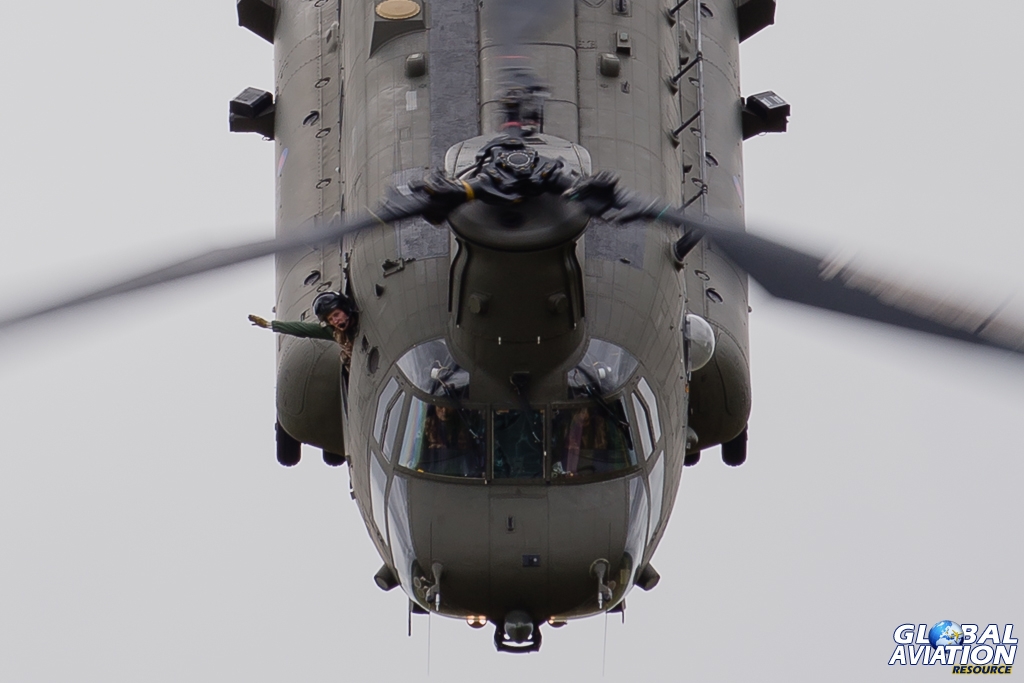
As I stand there watching the one hour long display practice for the 2013 display season I still find myself being amazed by the agility of the Chinook, despite having seen it displayed many times before. You could be forgiven for thinking that a large, heavy lift transport helicopter would be a slow and lumbering beast, but those who have seen the RAF’s Chinook display will know better. Thanks to the Honeywell T55-GA-714 engines and the impressive 4,168 HP that each of the two engines produce, the Chinook is far from short of power and you might be surprised to hear it has a higher top speed than the Apache.
Today is a big day for the team as their display supervisor, who is the Squadron Leader sat behind me with a radio link to the team (to give them feedback), has just approved the team down to display height (100 feet) for a complete display, at full speed, for the first time. The next step will be to achieve sign-off from the senior supervisor, who is a Wing Commander, followed by the Station Commander, before performing their PDA (Public Display Authorisation) run-through in front of the Commander of Joint Helicopter Command, which is scheduled for 23 May.

After four display practices, with only one break in the middle to allow a change of display crewman, the Chinook taxies back in and I get the chance to talk to the crew.
The team for this year consists of Flt Lt Paul Farmer who is the display pilot and Flt Lt Gareth Allen as his display co-pilot, while Flt Lt Kyle Thomas is the display manager and the display crewman role is performed by Sgt Andy Caldwell and Sgt Steven Jones.
It is Flt Lt Paul Farmer’s second year as the display pilot and 2012 was a good year for him, with his performances awarded a third place from the RAF Waddington International Air Show flying control committee, for his first display, and then the Steadman Display Sword for the best UK routine at the Royal International Air Tattoo. Reflecting on his experience at RIAT he tells me:
“RIAT was amazing because it was RIAT. The previous time I went to RIAT was after I had been unsuccessful in my first attempt at selection for the RAF. I was a little bit down, as you can imagine, as I watched the Red Arrows and all sorts of fantastic aircraft displaying. So it was quite nice for me then to go the following time, even though there was probably about twelve years in between, being the display pilot and coming away with the sword.”
Of course Paul went on to pass selection and he now has over 2,200 hours on the Chinook with six deployments to Afghanistan under his belt, and as well as being the display pilot he is also the Chinook Force Standards Officer.
Looking forward to 2013 he talks me through the changes to the display routine for this year, starting right at the beginning.
“The new thing we have put in for this year is starting with a nose-over to crowd centre on the b-axis, which hasn’t been done before.
“We are also working towards a 720 degree corkscrew, and on the top of the Gornji we are looking to make two revolutions compared to last year’s one, which I hope looks a bit more impressive.”
Also returning this year, by popular request, is the rolling landing that has been a firm crowd favourite for many years. Paul continues to tell me how the team came up with the routine for this season….

“It’s a combination of looking at previous displays we have done and working out what would work while trying to make a display that is tight. We are lucky in the Chinook as we can pretty much display in front of the crowd line at all times, without having the problem the jets have with having to have a large turning circle as they are very fast. At all stages we are looking to try and keep everything as close to crowd centre and to the crowd as possible, so that it is as impressive as possible.”
As well as making sure the display looks good, there is also the technical aspects that have to be considered and especially the impact the wind can have on the display.
“There is a lot of figuring out what will work, making sure manoeuvres are done into the wind. The running landing for example, we need to have it work so that we end up running into wind.
“The sideways flight with the crewman waving from the ramp needs to be done with the wind from our right whilst we are moving left, so we don’t have a really slow progression over the ground. With the winds towards us there is a sideways flight limit of 40 knots. So, if I had a 40 knot wind from one direction and I was going into that wind I couldn’t move in that direction, so if there was a 30 knot wind I’d only be allowed to do 10 knots. We want it so the wind is helping us, whilst staying within our 40 knot limit.”

The routine is an ever-evolving process and is being reviewed each time it is flown to try to improve it. Paul explained to me how they modified the display previously and what they modified today.
“When we start and do the nose-down to crowd centre, we then offset to the right for a pedal turn, then offset to the other way for another pedal turn. As we were coming down out of that, we were going to go straight into a nose-down quick-stop, but we found in order to start that we had to be slow, so I had come out of the last pedal turn with a nose up attitude, which didn’t look very good. So, for the one from the last display, we put in a 360 degree turn to allow me to bleed the speed off whilst still holding a nice nose down attitude from the exit of the pedal turn, so that I can go into the nose-down quick-stop at about 80 knots, which means we don’t damage the aircraft; if we go in at 120 knots we damage the aircraft which is not what we want to do.
“Today we reordered the nose-over to crowd centre and the roller-coaster, so before I do the running landing it gives me just a bit more space to be further down wind and I have more space to get down from what is essentially a stall turn at about 600ft with zero airspeed. We can then accelerate as we come out the back of it, as potential energy becomes kinetic energy as we come down; this allows me bleed off some of that speed so we can be within the limits to land on for the running landing.”

With a total of 18 tours of Afghanistan between the team members, I was keen to know if any of the routine was taken from operational flying?
“You wouldn’t do much of what we do in an operational theatre. The one thing that is similar, that we do use often, is the nose-down quick-stop. It’s not the nose-down quick-stop the guys use in Afghanistan, but it is something similar to it, which is an operational quick-stop where you use the pedals to slow down the aircraft a little bit quicker, and we’ve all used that many, many times in Afghanistan.
“It allows you to keep the speed on until the last minute. This allows us to run in right over the top at 150 knots, so we can go right there they are, and slow down right over their heads and keep our speed to make us less of a target to the Taliban.
“The over-the-shoulder we use at the end is definitely an operational manoeuvre.”
At their first display of the season, the RAF Cosford Air Show, as well as performing the solo display the Chinook Display Team will also be putting on a Medical Emergency Response Team (MERT) demo in conjunction with the AAC’s Apache, which will be providing top cover as it would in Afghanistan. The plan is for the demo to enact a full battle scene, which will include RAF Force Protection and troops with weapon mounted (WMIK) Land Rovers.
The demo was the idea of a Corporal, based at RAF Cosford, who unfortunately lost both his legs in an incident in Afghanistan and had experience of being extracted by the Chinook. The idea was put to JHC which authorised the demo and, while there aren’t currently any plans to recreate it at any other airshows, I asked Paul for his thoughts on the concept:
“We are thrilled to help with that, it is fantastic to paint that picture to the guys. We are very fortunate that the guys who work down the back of our aircraft are fantastic; in many, many cases lives have been saved as part of this and hopefully it will be a good addition for the Cosford Air Show.
“It is awful that the poor chap lost his legs but fantastic that he was saved and I hope he is okay watching it from the grandstands.”
If the MERT demo is as good as the troop insertion and extraction that the Chinook performed with the Apache as part of the short lived RAF Role Demo, it should be a great spectacle and should help to highlight further the important work the Chinook and its crews continue to perform in Afghanistan
I’d like to thank the RAF Chinook Display Team and Flt Lt Megan Henderson, MCO at RAF Odiham, for their assistance with creating this article and wish the team all the best with their forthcoming PDA.

The latest display schedule for the Chinook Display Team is available on their website http://www.raf.mod.uk/chinookdisplayteam/ and you can also follow them on Twitter https://twitter.com/ChinookDisplay.



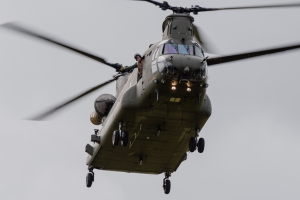
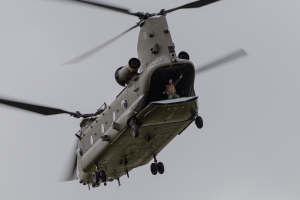




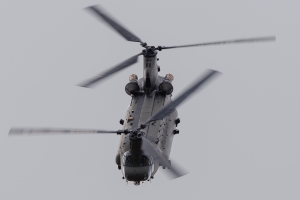





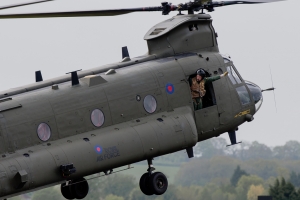

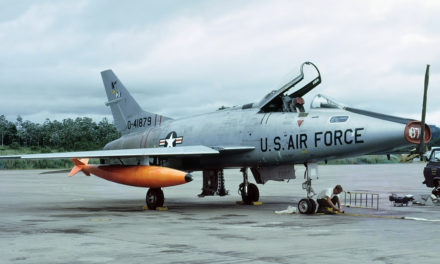



Excellent shots and text, which whet the appetite for seeing them for real.
Many thanks.